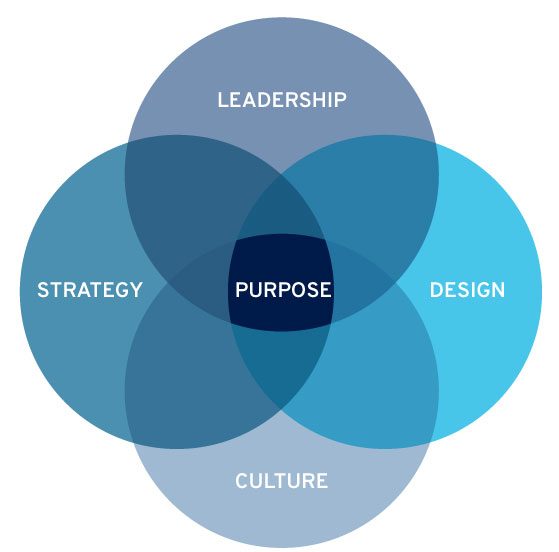Why Purpose is Fundamental for Strategic Alignment and Peak Performance
It will come as no surprise that organisation performance can be optimised by achieving strategic alignment. There is no point in crafting a strategy, developing leaders, designing an organisation or changing the culture without a clearly defined organisation purpose. In this article we examine why identifying the purpose of your organisation is where strategic alignment and peak performance starts.
Before we delve into purpose let’s consider strategic alignment. Strategic alignment can be achieved when all key elements of the business are organised and aligned (i.e. they support and are supported by one another) in such a way that it is able to achieve its purpose or mission.
One of the key elements of a successful business is well-crafted, implemented and reviewed strategy. Other key elements include effective leadership, an optimised organisation design (including operating model, structure and ways of working), and the organisation culture required to achieve success.
Strategic alignment is also critical to optimise business performance. Conversely, each element can be a constraint on the others, and overall performance, if not properly aligned.
But it doesn’t start here. It starts with purpose.
Why is purpose important?
A purpose defines the ‘why’ of an organisation. Why does your organisation exist (beyond making money), and why do you do what you do? If you are not clear about the ‘why’, how can you develop a meaningful strategy to achieve success? Simon Sinek in his (now classic) book, ‘Start with Why’, writes:
“Very few people or companies can clearly articulate why they do what they do. By why I mean your purpose, cause or belief – why does your company exist? Why do you get out of bed every morning? And why should anyone care?… People don’t buy what you do, they buy why you do it.”
The purpose becomes a kind of ‘North Star’, providing direction for all elements of the organisation to follow.
A clearly defined purpose should guide what you do and how you do it, including when engaging the customer/public, recruiting new employees and as a guide for decision making.

All elements must align with each other – strategic alignment begins with purpose
As a bonus, there are numerous other advantages of having a clearly defined and driving purpose. Research has shown purpose-driven companies have more motivated employees, more loyal customers, and are more profitable.
- 90% of consumers would switch brands to one that was purpose-driven and had similar price and quality[1]
- Employees have twice the job satisfaction and are three times more likely to stay with their organisation[2]
- 49% of employees would trade a portion of their salary to continue in their current role with an added sense of purpose[3]
- Employees whose work feels meaningful work longer and are absent less[4]
- Over a 10-year period, investment in purpose-driven companies would have been 400% more profitable than in the S&P 500[5]
A purpose driven organisation can be a powerful competitive differentiator
This matters both for private and public sectors where the competition for talent (amongst other things) is intense.
While each organisation will be different, the following may be useful to keep in mind as you develop your organisation’s purpose.
- Consider what impact your organisation is trying to have on the customer, industry, or society as a whole.
- What are your people passionate about?
- Be practical, relevant and true to your brand.
- Be consistent and ensure leaders are on-board (practice what you preach).
- Show your commitment to your purpose with employees and customers by demonstrating and communicating what steps you’re taking to achieve your purpose.
- Align metrics and incentives with your purpose.
A well-crafted and implemented business strategy, great leaders, an optimised organisation design and incredible culture are all important -indeed, critical for success. But they only tell part of the story for successful organisations, and the story begins with a purpose. Purpose not only provides direction for your business, but it can also be a powerful competitive differentiator, and it is a critical component against which all elements must align.
“Purpose-driven companies attract the best minds, have the most passionate customers, achieve wild success and change the world. When purpose and passion are combined, the impact is powerful not only for individuals but also on the public they serve to help create a brighter future for everyone.” – Peter Fisk
Noetic Group works with a range of organisations to design, implement and review their strategies and to help ensure strategic alignment between all critical business elements, including purpose, strategy, leadership, design and culture. If we can help your organisation find its purpose, achieve strategic alignment, or with any one of these critical elements, get in touch.
[1] 2013 Cone Communications/ Echo Global CSR Study
[2] ‘Why You Hate Work’, New York Times. By Tony Schwartz and Christine Porath, May 30, 2014 – https://www.nytimes.com/2014/06/01/opinion/sunday/why-you-hate-work.html?_r=1
[3] ‘Purpose At Work: How To Create Meaning To Motivate Your Team’, By Laurence Bret-Stern – Jun 14, 2018 – https://minutehack.com/guides/purpose-at-work-how-to-create-meaning-to-motivate-your-team
[4] ‘Meaning and Purpose at Work’, BetterUp – https://get.betterup.co/rs/600-WTC-654/images/betterup-meaning-purpose-at-work.pdf
[5] Firms of Endearment by Raj Sisodia – https://www.firmsofendearment.com/
